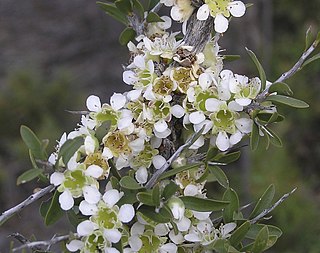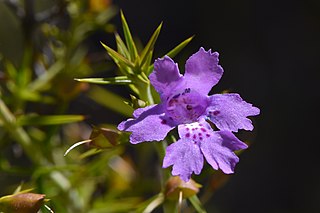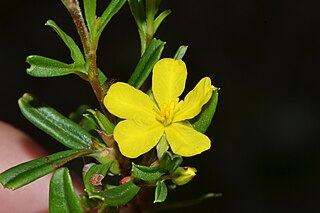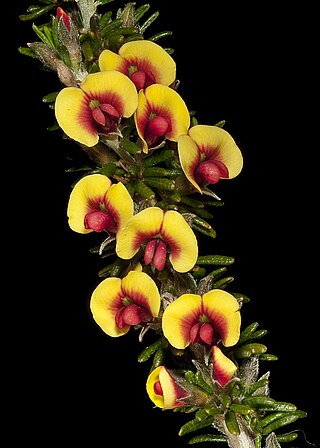
Chorilaena quercifolia, commonly known as karri oak or chorilaena, is a species of bushy shrub that is endemic to the karri forests of south-west Western Australia. It is the sole species in the genus Chorilaena. It has papery, broadly egg-shaped leaves with lobed edges and variously-coloured flowers arranged in umbels of five, the sepals and petals hairy on the outside and the stamens protruding beyond the petals.

Darwinia vestita, commonly known as pom-pom darwinia, is a species of flowering plant in the family Myrtaceae and is endemic to the southwest of Western Australia. It is an erect, bushy shrub with crowded egg-shaped, oblong, or linear leaves and more or less spherical heads of white to reddish-pink flowers.

Leptospermum spinescens, commonly known as the spiny tea tree, is a species of spiny shrub that is endemic to Western Australia. It has thick, egg-shaped to elliptical leaves on a short petiole, white or greenish cream flowers, and fruit that remain in the plant for years after reaching maturity.

Boronia cymosa, commonly known as granite boronia, is a plant in the citrus family Rutaceae and is endemic to the south-west of Western Australia. It is an erect shrub with linear, more or less cylindrical leaves and groups of relatively small, pink four-petalled flowers arranged on branched flowering stems.

Olearia ciliata, commonly known as the fringed daisy bush, is a small shrub with large clusters of bright purple-blue flowers on a single stem.

Hemiandra linearis, commonly known as speckled snakebush, is a species of prostrate to ascending shrub that is endemic to the south-west of Western Australia.

Comesperma integerrimum is a twining shrub or climber in the family Polygalaceae.

Gompholobium aristatum is a species of flowering plant in the family Fabaceae and is endemic to the south-west of Western Australia. It an erect shrub that typically grows to a height of 10–80 cm (3.9–31.5 in). It flowers between July and December producing yellow, pea-like flowers. This species was first formally described in 1837 by George Bentham in Stephan Endlicher's Enumeratio plantarum quas in Novae Hollandiae ora austro-occidentali ad fluvium Cygnorum et in sinu Regis Georgii collegit Carolus Liber Baro de Hügel from specimens collected in the Swan River Colony. The specific epithet (aristatum) means "awned", referring to the leaves.

Hibbertia perfoliata is a species of flowering plant in the family Dilleniaceae and is endemic to Western Australia. It is a weak, ascending or prostrate, spreading shrub that typically grows to a height of up to 40 cm (16 in). It flowers from September to December or from January to March and has yellow flowers. The species was first formally described in 1837 by Stephan Endlicher from an unpublished description by Charles von Hügel and Endlicher's description was published in his book Enumeratio plantarum quas in Novae Hollandiae ora austro-occidentali ad fluvium Cygnorum et in sinu Regis Georgii collegit Carolus Liber Baro de Hügel. The specific epithet (perfoliata) means "perfoliate".

Hibbertia racemosa, commonly known as stalked guinea flower, is a species of flowering plant in the family Dilleniaceae and is endemic to the south-west of Western Australia. It is an erect or ascending, spreading shrub that typically grows to a height of 10–75 cm (3.9–29.5 in) and produces yellow flowers between July and December.

Kennedia carinata is a species of flowering plant in the family Fabaceae and is endemic to the south-west of Western Australia. It is a prostrate shrub with trifoliate leaves and reddish-purple, pea-like flowers.

Mirbelia spinosa is a species of flowering plant in the family Fabaceae and is endemic to the south-west of Western Australia. It is a spiny shrub with narrowly linear leaves and yellow, orange and reddish-brown flowers.

Lechenaultia floribunda, commonly known as free-flowering leschenaultia, is a species of flowering plant in the family Goodeniaceae and is endemic to the south-west of Western Australia. It is an openly-branched shrub or subshrub with crowded, narrow, fleshy leaves and compact groups of pale blue to pale mauve or creamy white flowers.
Lasiopetalum cordifolium, is a species of flowering plant in the family Malvaceae and is endemic to the south-west of Western Australia. It is an erect shrub with hairy stems, heart-shaped leaves and pink, cream-coloured or white flowers.

Sphaerolobium alatum is a species of flowering plant in the family Fabaceae and is endemic to the south of Western Australia. It is a slender, leafless shrub with yellow and reddish-brown flowers from September to November.
Sphaerolobium fornicatum is a species of flowering plant in the family Fabaceae and is endemic to the far south-west of Western Australia. It is a leafless shrub that typically grows to a height of 0.1–1 m and has yellow or orange and red flowers from October to January.

Sphaerolobium grandiflorum is a species of flowering plant in the family Fabaceae and is endemic to the south of Western Australia. It is an erect, slender, leafless shrub with red, yellow and orange flowers.

Sphaerolobium linophyllum is a species of flowering plant in the family Fabaceae and is endemic to the south of Western Australia. It is a prostrate to ascending shrub with a few narrowly linear leaves and red, yellow and orange flowers.

Spyridium spadiceum is a species of flowering plant in the family Rhamnaceae and is endemic to the south of Western Australia. It is an erect or semi-prostrate shrub with narrowly oblong to oval leaves and heads of hairy flowers with brown bracts at the base.

Billardiera speciosa is a species of flowering plant in the family Pittosporaceae and is endemic to southern Western Australia. It is a slender climber that grows in coastal heath and has narrowly elliptic leaves with the edges rolled under and groups of purple or mauve flowers.


















